

You can listen to the random walk here: The x-coordinate is the left channel and the y-coordinate is the right channel (best heard on headphones, but be careful the volume is not too loud). In musical terms, there are two voices, each starting at A440. At each time step (1/16th note), one of the voices moves by one tone in the scale of A major, either up or down, while the other does not move. The choice of which voice moves--and where--is completely random each time, with all possibilities being equally likely. The graph of these two coordinates as a function of time is as follows:

Here's a score.
The random walk takes place on a square lattice grid like this (which, by the way, also exhibits a variation of the scintillating grid illusion):

However, since the coordinates were converted to a major scale and the tones in a scale vary by whole or half tones, it is akin to walking on this grid:
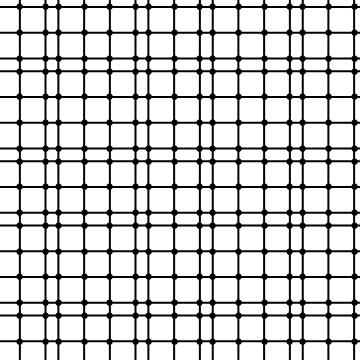
On the other hand, our hearing is logarithmic, so in terms of pitch frequencies, it is like walking on this grid:
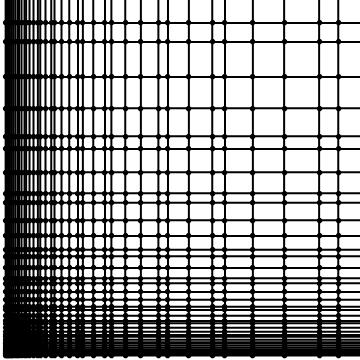
If we draw every edge the random walker crosses in the above random walk, we will get an indecipherable mess. However, suppose we draw an edge only when the walker arrives at a vertex it has never visited before. Let's do this on a finite (connected) graph, like a 4-by-4 piece of the square lattice. In this case, the walker will eventually (with probability 1) visit each of the 16 vertices, and at this point, no new edges will be drawn, so we might as well stop. What will we see? Take a look:
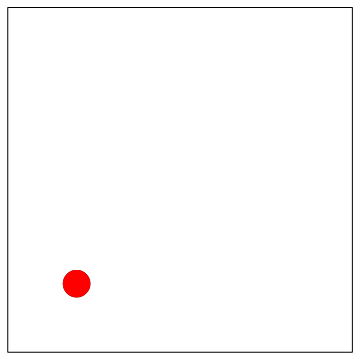
We got a spanning tree of the graph, i.e., a subset of the edges of the graph such that for every pair of vertices, a and z, of the graph, there is a unique path of edges in the spanning tree that connects a to z. Of course, the particular spanning tree that results is random since the walk is random. What is its distribution? Amazingly, it is uniformly distributed among all possible spanning trees of the graph, i.e., all are equally likely!
A uniform random spanning tree (UST) of a 9-by-9 grid in the plane looks like the picture on the left here:
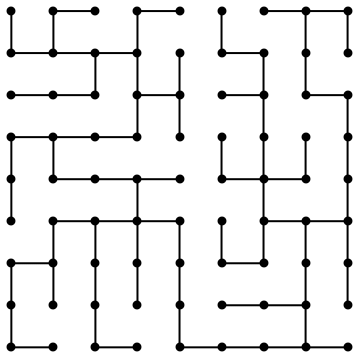
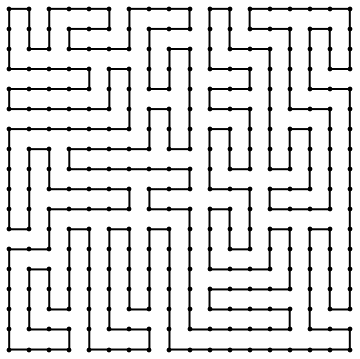
There are a lot of spanning trees; in fact, there are 8,326,627,661,691,818,545,121,844,900,397,056 spanning trees of the 9-by-9 grid. Surrounding a spanning tree by a curve, one gets a random Peano-like curve that visits each lattice point exactly once in an 18-by-18 region before returning to its starting point, as on the right above. In other words, this curve is a Hamiltonian cycle in the 18-by-18 grid graph. (There are other Hamiltonian cycles in the grid graph that don't come by surrounding spanning trees.) You can listen to the Peano-like curve, starting in the middle of the region, here: In musical terms, the curve has two voices, each starting at A440. At each time step (1/16th note), one of the voices moves by one tone in the scale of A major, either up or down, while the other does not move. The pair of voices takes each value in an 18-by-18 array of such notes (324 altogether) exactly once, before returning to its starting point. The graph of its coordinates is this:
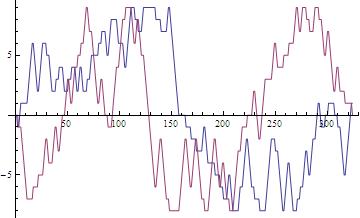
Here's a score.
You can listen to the music at the same time as watch a walker move along the curve here:
With extras at the start and end, see this:
If you prefer, you may view
this
YouTube video.
The Peano-like curve has a very interesting scaling limit, i.e., a limiting random curve in a square if we take finer and finer lattice meshes inside the square. This random curve will be "space-filling", i.e., it will visit every point in the square, even though it never "crosses" itself. It is closely related to SLE (stochastic Loewner evolution). The SLE processes were introduced by Oded Schramm and formed a major part of the work of Schramm, Greg Lawler, and Wendelin Werner that contributed to Werner's earning a Fields Medal. Here is a picture of a Peano-like curve from a tree on a 99-by-99 grid, where the hue denotes the progress along the curve, just like in the movie:
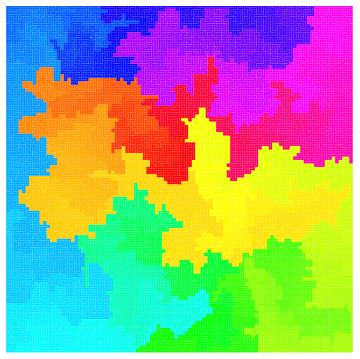
For more information on random spanning trees, go to the
random mazes page or see Chapter 4 in
the book I've written with Yuval
Peres.
The real advantage of sound comes when we do random walk in higher dimensions, which are harder to represent visually on the screen. Pólya's theorem says that simple random walk in any dimension at least 3 is transient, which means that with probability 1, the walker will return to its starting point only finitely many times and indeed will never visit any vertex infinitely many times; thus, it wanders off to infinity. You can listen to 3D random walk here: The x-coordinate is the left channel, the y-coordinate is the right channel, and the z-coordinate is in the middle (best heard on headphones). The graph of these 3 coordinates as a function of time is as follows:

Here's a score.
You can listen to 4D random walk here: The x-coordinate is the left channel, the y-coordinate is the right channel, the z-coordinate is in the left middle, and the w-coordinate is in the right middle (best heard on headphones). The graph of these 4 coordinates as a function of time is as follows:

Here's a score.
To see more information about random walks, visit Interactive Random Walk Demonstrations.
rw such
that rw[n,seed] gives a list of vertices in the plane starting
at the origin taking n steps using seed for the random number
generator's seed:
orig={0,0};nbrs={{0,1},{1,0},{0,-1},{-1,0}};
rw[n_,seed_]:=Module[{},SeedRandom[seed];Prepend[Accumulate[RandomChoice[nbrs,n]],orig]]
I used the seed 1234. I did not compare to other results and choose the best-sounding result. I just took what came. I did decide the starting pitch (A440) and did decide to use the A major scale. I didn't listen to other choices. I chose to make the random walk steps correspond to 0.2 sec, just because that seemed right a priori.
For random walk in 3D, I changed the first line above to
orig={0,0,0};nbrs={{0,0,1},{1,0,0},{0,0,-1},{-1,0,0},{0,1,0},{0,-1,0}};
while in 4D, to
orig={0,0,0,0};nbrs={{0,0,0,1},{0,1,0,0},{0,0,0,-1},{0,-1,0,0},{0,0,1,0},{0,0,-1,0},{1,0,0,0},{-1,0,0,0}};
Longer random walks would eventually leave the realm of what we can hear.
They would be better restricted to a portion of the grid. Alternatively,
one could take a random walk on a torus and use a Shepard (circular) scale.
I output the notes using Mathematica to write a score using the free software Lilypond. For the score, I chose 1/16th notes for each time step, which made the tempo 75 beats per minutes. I chose the time signature 4/4 since that seemed to fit best walking on a square grid. Measures were just for convenience in following the piece. For the Peano curve, I filled out the last measure with the starting note; an alternative would have been an eternal repeat. Also, 324/16 would have been a natural time signature.
I also exported the notes to the free software Midge to create midi files, which are very small. (However, some combinations of browsers and operating systems can't play midi files, so I also converted to mp3 and ogg.) I would have liked to have used a pure sine wave, but that doesn't seem to be supported, so I used the midi patch called square lead, which is fairly suitable as well. I would also have liked to fade the random walk pieces to convey the idea that they go on forever, but fading is not possible in midi. Instead, I just lowered the volume once.
I drew graphics of the random walk in Mathematica and exported the result to gif, which makes a fairly small file. Other graphics were exported to jpg, which is also fairly small.
The movie was made as follows. The video came from exporting graphics from Mathematica to avi. They were combined with the midi sound in QuickTime Pro and iMovie on a Mac, and exported to wmv, which seemed to be the best. Still, the video quality is noticeably degraded. The Flash (swf) vector-graphics video was made slightly differently. Graphics were exported as eps frames, which are vector based. These were converted to ai frames (also vector based) via Adobe Illustrator so that they could be imported into Adobe Flash. The sound from the previous video was converted to asnd using Adobe Soundbooth (maybe this wasn't necessary) and then imported into Flash. The result was exported as swf, converting the sound to mp3. The QuickTime version of this was produced simply by exporting as mov. Flash is no longer supported, so it was converted to webm.
Here is Mathematica code that gives a function t[n]
whose value is the number of spanning trees on an n-by-n grid:
t[n_]:=n^(-2) Product[If[{j,k}=={0,0},1,4-2Cos[Pi j/n]-2Cos[Pi k/n]],{j,0,n-1},{k,0,n-1}]
For more technical details, visit this page.
| Back to top of page | Privacy policy | View My Stats |